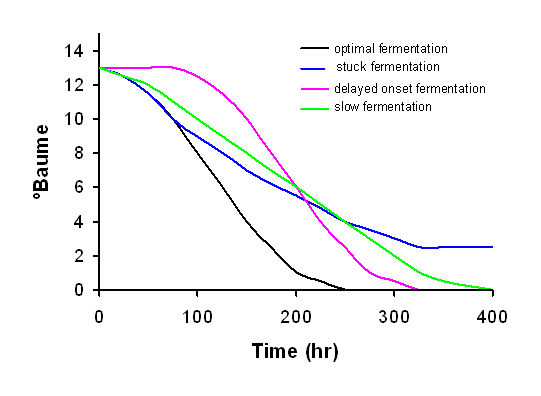Download the calculators:
- Access the fermentation graph calculator (Baume) (Microsoft Excel format, 79kb)
- Access the fermentation graph calculator (Brix) (Microsoft Excel format, 76kb)
Notes:
- You will require access to Microsoft excel to view these graphs.
- These graphs can be downloaded, modified and replicated to suit your wineries needs.
- Temperature limits for the fermentation, along with an optimal fermentation rate curve will be displayed on the graph.
- We are currently trialling these fermentation graphs. Please contact Winemaking Services to provide feedback.
Fermentation monitoring
It is useful to monitor your ferment (generally Baume or brix) and temperature daily, or twice daily, and to represent it graphically. This allows you to more clearly observe when fermentations begins, starts to slow down or becomes a stuck fermentation.

Optimal fermentation
An optimal ferment duration may be anything from 7 to 14 days; a generally accepted rate of one baume drop per day is often desired. An optimal fermentation curve is shown here in black.
Delayed onset fermentation
A delayed onset to fermentation is shown in pink.
A delay in the onset of fermentation can occur in the following situations:
- fruit with high baume. Yeast are put under osmotic stress due to high sugar concentration of the juice. They lose water and shrink to adapt to the high osmotic pressure of the juice and devote their energy toward building stronger cell walls to cope with their environment.
- insufficient yeast inoculum
- native microbial competition
- yeast toxins
Slow fermentation
A slow fermentation is shown in green.
Slow ferments are not necessarily bad, so long as they continue to metabolise sugar.
Stuck fermentation
A stuck ferment is shown in blue.
Stuck ferments occur when there is no continual decrease of sugar, and some action is required. For restarting a stuck fermentation, access Prevention and management of stuck alcoholic fermentations (PDF, 41kb).
Where can I find out more information about stuck alcoholic fermentations?
See ‘Where can I find out more information about stuck alcoholic fermentations?’ on the Frequently asked questions page.

